This was published 5 years ago
White-bred terrorist: the making of a killer
In March, a 28-year-old loner from small-town NSW committed New Zealand's worst mass shooting. Paving his path to the devastation: the dark online world of white supremacists.
By Nick O'Malley, Tim Barlass and Patrick Begley
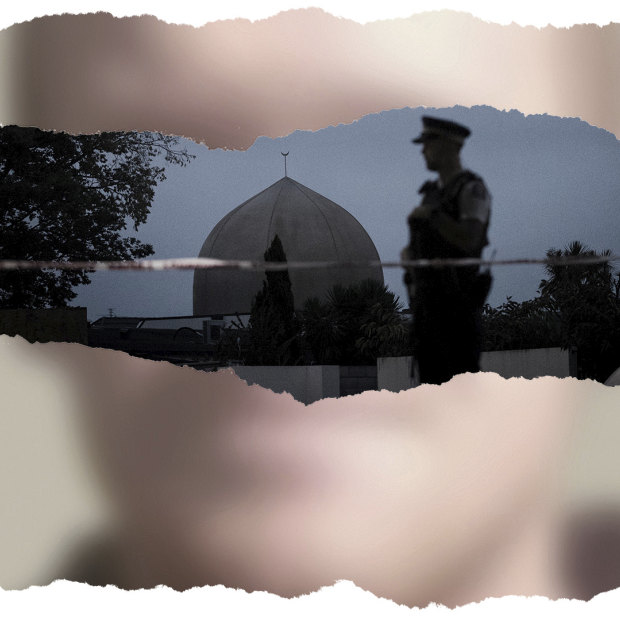
In the end, it came down to this: a mattress and a black bookshelf, a colander and a dish rack, a few battered suitcases and a broken electric fan. A bottle of Steinlager and a family pack of Bluebird potato chips. A toaster and a worn vinyl computer chair.
A week after his shooting spree in Christchurch, the material total of Brenton Tarrant’s New Zealand life was dumped into a caged trailer outside his unremarkable rented home in Dunedin on the country’s South Island. A local contractor carted it off in a single load, with instructions from New Zealand Police that none of it be sold or used. The police had already secured as evidence most of the other possessions the 28-year-old Australian had brought with him when he moved across the Tasman 18 months prior.
The police had first arrived at the property the previous Friday, just hours after the March 15 gunfire ceased. A neighbour recalls how they appeared as he was enjoying a smoke on his front porch in the early autumn dusk. It might as well have been an alien visitation. One moment he was alone with his thoughts, the next officers from the Special Tactics Group were there, clad in black body armour and helmets, their faces hidden by masks, assault rifles gripped in their gloved hands. He was ordered to leave as they searched Tarrant’s home for explosives.
Forty-nine people already lay dead in Christchurch, with another 51 injured. Within a couple of months the numbers had flipped, with 51 people dead and 49 injured in what New Zealand Prime Minister Jacinda Ardern would describe as "one of New Zealand’s darkest days".
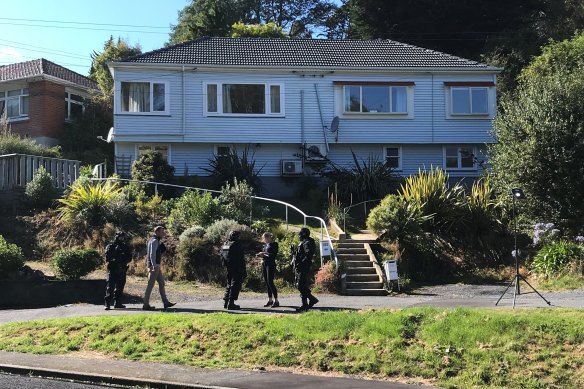
Tarrant's rental home in Dunedin. Neighbours remember him as unremarkable.Credit: Michael Wright/Stuff
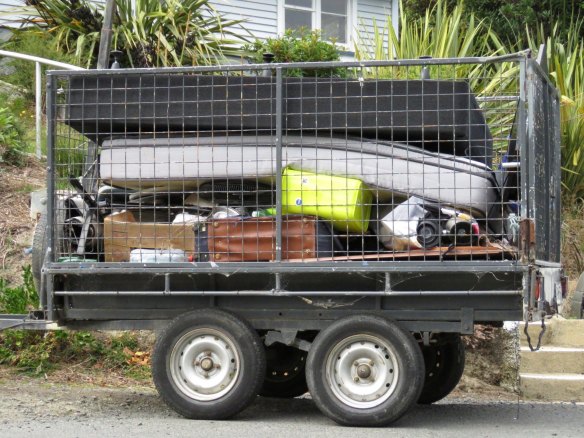
Items taken from Tarrant's Dunedin rental after the shootings.Credit: Hamis McNeilly/Stuff
The police response had been marked by a mixture of heroism and luck. Tarrant fired his first shots at 1.41pm, during Friday prayers at the Al Noor Mosque in central Christchurch. By the time police arrived about six minutes later Tarrant had already departed, leaving 42 bodies behind him. At 1.52pm he attacked another mosque, this one in the suburb of Linwood. He fled after just three minutes, hunted from the scene by Abdul Aziz, a furniture shop owner who was at prayer with four of his sons and ran into Tarrant’s gunfire armed with the only weapon he could find, a hand-held EFTPOS scanner he’d grabbed from a desk by the door. By then, seven more were dead.
Tarrant’s manifesto, published online minutes before his massacre began, suggests he was en route to a third target, a mosque in Ashburton outside Christchurch, when two experienced rural cops intercepted him. In Christchurch that day for training on how to deal with armed offenders, the pair responded to an officer call-out by searching back streets they figured the attacker might use. When they saw a 2005 Subaru Outback driving erratically they acted swiftly, ramming the car off the road then wrestling the driver from his seat.
By 1.59pm Tarrant was in custody, and by 2.15pm he was being questioned at Christchurch Central Police Station.
Despite the arrest, the city remained in crisis. Tarrant had live-streamed his attacks on Facebook and the footage was being reposted and replayed online. It was unclear whether all the images were from the two mosque shootings, and there was a false report of an attack at the Christchurch hospital where survivors were being taken. Authorities needed to know whether Tarrant was acting alone or as part of a terrorist network. Unsure, they locked down the city, only removing the roadblocks to allow workers and school children to make their way home at 6pm that night.
Determining whether Tarrant was acting alone turned out to be complicated. He was the only shooter; but equally, he was part of a web of online and real-world extremism that had helped radicalise him, then cheered him on as he went about his killing. Though Christchurch police ended his massacre less than 20 minutes after it started, the threat from the ideology that forged him lingers.
To understand this contradiction, it’s worth tracing the path Tarrant trod from a small town in NSW, out into the world, then back across the Tasman to New Zealand.
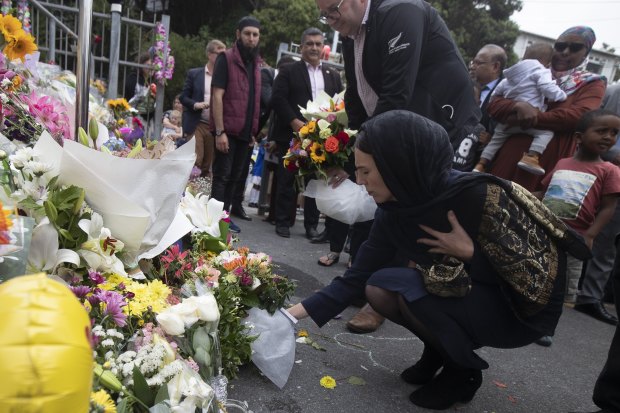
New Zealand Prime Minister Jacinda Ardern pays tribute to victims of the shooting.Credit: Robert Kitchin/Stuff
Tarrant was born in 1990, the second of two children to Rodney, a fitness fanatic who worked the local garbage run, and his wife Sharon, a teacher. The family lived in Grafton, a pretty town lined with jacaranda trees in the Northern Rivers region of NSW. With a population of less than 20,000, Grafton skews a little older, a little poorer and significantly whiter than is average for Australia, with 87 per cent of its residents born in the country.
When Good Weekend visits, it finds former school and work colleagues in shock at what Tarrant has done. He was odd, largely solitary and prone to poor practical jokes, but none of those questioned foresaw what he would go on to do. His radicalisation, it seems, had its roots in the confines of his bedroom, where he sat for hours at a time looking at his computer screen. It was then turbo-charged after he left his home town to travel abroad.
Those blindsided by his actions include Marie Fitzgerald, Tarrant’s maternal grandmother. A brisk, white-haired woman in her 80s, Fitzgerald lives in a seniors’ lifestyle community on the outskirts of Grafton. Her modest living room is made homely with family photos, some of her now infamous grandson. There are roses on the table sent in sympathy by a friend she hadn’t heard from for years. Asked how the family are finding things, Fitzgerald says that Sharon, Tarrant’s mother, barely slept for 16 nights after the shootings. She, however, has had no such problems.
"Everybody else in the family is saying, ‘How the hell are you sleeping?’ And I say, ‘Well, I didn’t do it.’" Upon learning that Tarrant has complained about his treatment in maximum-security Auckland Prison, Fitzgerald glances at a photo of her grandson as a boy, with a mop of curly red hair on his head and the innocence of youth on his face. "Who is he to complain when he has done such a thing? They can give him soup for the rest of his life … Yet he was such a dear little boy."
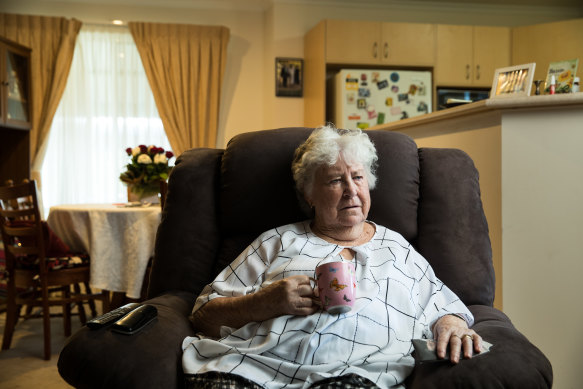
Marie Fitzgerald, Brenton Tarrant's grandmother, in her home in Grafton, NSW. Credit: Janie Barrett
Fitzgerald describes babysitting Tarrant and his older sister Lauren while their mother taught swimming at the local pool. "He was a naughty little boy in some respects – running away from Nanna." She talks of Rodney and Sharon splitting up when the kids were little, blaming the divorce in part on Rodney’s increasing obsession with fitness, including participating in marathons and triathlons both here and overseas, which strained the family’s finances.
Tarrant was no athlete, but rather a chubby kid with little physical skill. "It wasn’t his expertise. You’d see him sitting on the sidelines or at the goalpost playing in the dirt, with everything going on around him," says Fitzgerald. Lauren was the sporty one: "We used to go and watch Lauren play hockey." Things started to change at high school, however, when a knee injury prompted Tarrant to join a gym. Like his father before him, he became obsessed.
Some who went to Grafton High with Tarrant, and still live in the town, recall a man without close friends who was given to playing pranks.
"He was a pretty cheeky young bloke," says Mitchell Firth, who works as a plumber at the new jail being built in town. "There was a little bit of mischief but nothing real horrendous." Firth thought Tarrant smart. "If there was a topic someone was talking about, he would know a hell of a lot more about it than anyone else. A lot of people would focus on one side of the topic while he would do his research all the way around it."
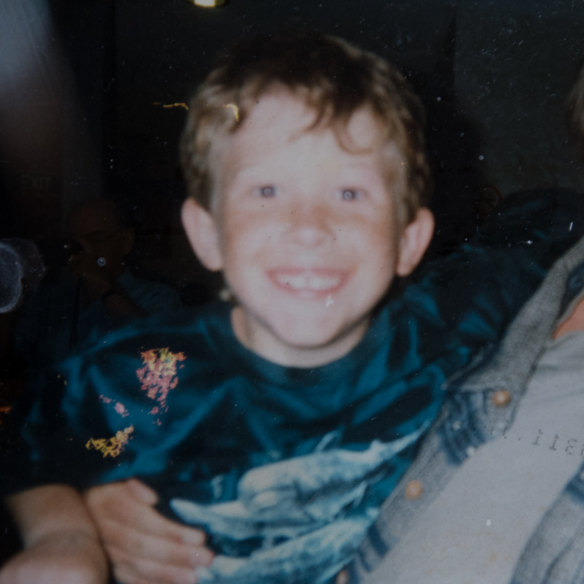
Brenton Tarrant as a child.
Another former school colleague, Aurey Marsh, says Tarrant was "a bit of a bully and a bit of a bloody menace" in his younger years. He recalls a year-10 prank in which Tarrant shredded newspapers and put them on top of the fans and airconditioner. "When the teacher came in and turned the fans on, all this shredded paper flew out." Marsh thought Tarrant had grown out of it, then "My missus sent through a thing to say what had just happened; I was at work. She said it was Brenton and I thought, ‘That means nothing to me.’ Then she says ‘Brenton Tarrant’ and I thought, holy shit! I never would have picked him to do anything like that."
Tarrant’s interest in fitness grew once he finished school, when he took a job as a personal trainer at the Big River Gym in town. One of the regulars was John Heffernan, the silvery-haired former governor of Grafton Jail. He remembers Tarrant concentrating on free weights rather than machines, and though he can’t recall exactly how much Tarrant lifted, he remembers it being too much for him.
"He used to grunt and throw the weights down, cutting into the carpet," he says. "He was oblivious to it. He did damage [the floor] on a couple of occasions. He pulled his back at one stage, which put him out of action for a while. For the size that he was and the age that he was, he had to take a bit more care in what he was lifting." Heffernan remembers Tarrant as a loner. "He was friendly, but I got the impression his social skills were not that great. He didn’t seem to be one that mixed very well. [But] there were no outbursts of anger or anything like that."
Tarrant’s boss at Big River, Tracey Gray, also remembers a young man who was awkward, though not violent, nor a bigot. "He didn’t show extreme views on religion, race – we actually trained some mixed-race clients at the facility. He never spoke ill of anyone behind their back based on race, appearance or beliefs or religion. Never any indication. As far as the training goes, he turned up, I never had to tell him what to do."
He didn’t do steroids – as far as Gray could tell – but was fanatical about what he ate, and tried to encourage gym clients to adopt his strict dietary regimen. "He could probably live a lifestyle like that, but if you are training people, mums or elderly people, you can’t always [expect them to] live to that kind of strictness."
Tarrant pushed himself, sometimes training for two or three hours at a time. On occasion, Gray would have to prompt him to go home and shower, and once even bought him some work shirts. He was "on the outer of social circles", she says, "not the bubbly, chatty one that could stand here and talk to anyone". But his confidence grew with his fitness and body bulk.
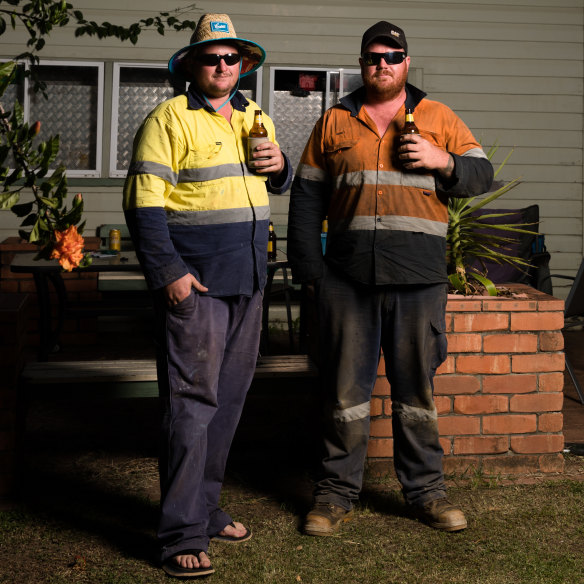
Mitchell Firth and Aurey Marsh, two former classmates of Brenton Tarrant, in Grafton, NSW.Credit: Janie Barrett
At about this time, his father Rodney, who had spent his working life hurling building scrap into garbage trucks, fell ill with mesothelioma, a cruel killer of a disease most commonly caused by exposure to asbestos. He died in April 2010, aged 49, three years after diagnosis. Brenton was 20 and living with him, and when not in the gym, spending an increasing amount of time on Facebook. "I tend to think living with his father and watching him die must have been a terrible thing," says Marie Fitzgerald. "I thought it must have played some part when his father died."
Rodney Tarrant received compensation for his illness, thought to be about $500,000, and believed to have been shared between his two children. Tarrant turned to a website, Aussie Stock Forums, for advice on what he should do with the money; indeed, with his life. Under the name ferretbiter, he joined a discussion about whether the potential for high pay or work satisfaction should guide career choices. You can see in his writing his habit of not following full stops with a space; a style that marked the manifesto he would later publish. (For clarity, Good Weekend has removed his grammatical quirks in the following excerpts.) You get the sense of a young man freed of school and liberated by cash, almost suffocated by the sudden shocking scope of his options. You also sense his shift from socially awkward outsider to someone whose physical changes have made him cockier, at least behind a computer, with the anonymity that comes with many chat forums.
Responding to someone who advised him to pursue career satisfaction, Tarrant wrote, "There is more to life than money. But while ever I work I do not have time to do what I truly enjoy doing, playing video games, snorting coke and hiring strippers. So whatever job gives me the largest amount of income in the shortest possible time is the job I will always choose. I work to retire, I do not work for fun. Yes any professional job or trade has the potential for a high income, but I’m looking for the trade which has the highest income on average." Someone else chimed in, saying that the tough jobs created by the mining boom were lucrative. Tarrant responded: "The only thing that stops me from joining the mining boom is that there is only one thing I believe is more important than wealth, and that’s good health. No use being rich if you are dead from gas exposure."
Earlier in the same thread, Tarrant had listed the pros and cons of careers he’d considered. He wrote that he could move to the city to earn more as a personal trainer, or sign up with the RAAF’s Airfield Defence Guard. He could create a booking website for sex workers. With a bit of study he could break into finance or real estate, though he worried he might not succeed in such competitive industries. "Ferret, you need to change your whole vibe, IMO," one online voice responded. "Based on what you’re saying, you have no self-confidence or self-respect, but it’s those very attitudes that are needed for success in any endeavour." Tarrant replied: "Truthfully I am extremely confident in every situation but talking over the phone (still don’t know what is up with that, I think it’s the lack of body language that throws me off). I run fitness classes with 20+ people daily who do nothing but stare/ask questions and mimic my movements for 60 mins and I enjoy it. My self-respect is through the roof, I can truly do anything I put my mind to.
"I wanted to lose weight, I lost 52kgs in 30 weeks. I wanted to be able to walk again, I can now leg press 1000lbs. I wanted to grow muscle, I’ve eaten the same thing every day for 3 years, gained 18kgs of muscle and have had 5 days off training out of 622. I am a goddamn monster of willpower, I just need a goal or object to work towards."
In a different thread, Tarrant confessed that he hadn’t told people in Grafton about his inheritance. He also claimed to have made money from cryptocurrency investments. "In my piss-ant town, you are the next Bill Gates if you have half a million in liquid assets," he wrote. "Thus why no one must ever know I’m not a broke personal trainer living with my mother."
My self-respect is through the roof, I can truly do anything I put my mind to ... I am a goddamn monster of willpower, I just need a goal or object to work towards.
Brenton Tarrant on an online forum
With money in the bank, his father dead and no close friends to speak of, Tarrant was ready to hit the road. "He didn’t drop me in the lurch," says Tracey Gray, the Big River Gym owner. "There was no altercation, he didn’t leave on bad terms. He just said he was going travelling. Fair enough. I knew that his father’s death had kind of given him a little bit of money and I thought, ‘Yeah, that would be the logical thing to do. You are young, haven’t got any commitments – go and see the world.’"
The last time Fitzgerald saw her grandson was in June 2018, when he returned home for his sister’s 30th birthday. "You wouldn’t have known there was anything wrong with him," she says. "Sharon was just happy that he came home, we could all give him a cuddle and say hello, because we never see him. We had a happy night down at the Jacaranda pub." It would be a different story, however, when Sharon visited her son in Dunedin, only months before the massacre.
The full extent of Tarrant’s travels are not clear, though from his social media posts and later reports by police and intelligence agencies, an outline of his movements can be traced. He began by driving a campervan through northern Australia in 2013 and 2014, before turning his attention to south-east Asia. In 2014, he wrote on a web forum of plans to visit 27 Asian regions, boasting that he had "unlimited time and budget". It’s not clear how much of this Asian odyssey Tarrant ever undertook; within a year or so, his interests had moved towards the shifting and often bloody historical borders between the Ottoman Empire and European states, between Islam and Christianity.
He travelled in 2016 to Serbia and surrounding countries, visiting the sites of historic battles as well as the museum of Marko Miljanov Popovic, a Montenegrin Serb general who fought against the Ottomans in the 19th century. Tarrant would later scrawl Popovic’s name on the weapons he used in his Christchurch attack.
The following year, Tarrant visited a number of other European countries including France, which has the largest Muslim population in the Western world, primarily due to immigration. According to his manifesto, Tarrant concluded that the "invasion" of France by "non-whites" that he’d been reading about had been "profoundly understated". He wrote of driving out of one particular French town with his emotions "swinging between fuming rage and suffocating despair".
Two other incidents in 2017 prompted him to plan his massacre. One was the April murder of 11-year-old Ebba Akerland, one of five people killed during a vehicular terrorist attack in Stockholm by a rejected Uzbek asylum seeker. The second was the election in May of Emmanuel Macron as president of France. Writing in his manifesto, Tarrant later described Macron as an "internationalist, globalist, anti-white ex-banker".
In August 2017, Tarrant decided to move to New Zealand, and "train" for an attack on Muslims elsewhere in the world. To his surprise, he concluded that his new country of residence was "a target-rich environment".
Tarrant travelled again after settling in Dunedin. In 2018, he visited Pakistan, a place filled with "the most earnest, kind-hearted, hospitable people in the world", read a message attributed to Tarrant on a hotel owner’s Facebook page, posted beside a picture of Tarrant in a garden. He also travelled to North Korea, then returned to Europe where he visited Bulgaria, stopping in Pleven, the site of a battle of the Russo-Turkish War of 1877-78.
According to Julia Ebner, an Austrian researcher into new waves of extremism with the London-based Institute for Strategic Dialogue, Europe’s new far right is showing a keen interest in such destinations. This is particularly so among those known as "Identitarians", who believe Europe is under attack by Muslims who seek to displace them in their "traditional lands" via "outbreeding" and immigration. Many in the movement champion the one-time Serbian ultra-nationalist leader Slobodan Miloševic, best known for war crimes including the 1995 murder of 8000 Bosniaks, a mainly Muslim minority, during the Bosnian War.
Author of the 2017 book The Rage: The Vicious Circle of Islamist and Far-Right Extremism, Ebner says that by emphasising an "inevitable" clash of civilisations, the Identitarian movement has been effective in recruiting young people who might be repelled by overt references to National Socialism and the Holocaust, and to circumvent laws in some European countries banning pro-Nazi rhetoric. To do so, it has harnessed the language of computer gamers and their online forums. Like Islamic State, Ebner tells Good Weekend, the Identitarian movement casts its members as victims of historical injustices and as warriors courageous enough to take up arms in defence of their people.
During this trip Tarrant visited Austria, home of Martin Sellner, a 30-year-old Identitarian leader. A fortnight after the Christchurch attack, Sellner’s home was raided by police. Sellner denied he and Tarrant ever met in person, but confirmed to the BBC that they’d exchanged emails. Sometime in 2018, Tarrant donated €1500 ($2400) to Sellner’s cause. It’s understood Austrian authorities are investigating links between Sellner and Tarrant.
"If you ever come to Vienna, we have to go for a coffee or a beer," Sellner wrote to Tarrant.
"The same is true for you if you ever come to Australia or New Zealand," replied Tarrant. "We have people in both countries who would like to welcome you to their home."
Ebner thinks it unlikely Tarrant was drawn to the Identitarian cause by one particular person or in one specific location. Rather, she thinks his online world was driving his travels, and that his travels were fuelling his online conversations, each aspect of his life reinforcing the other.
As Tarrant began his travels, the online ecosystem that has supercharged far-right extremism around the world was beginning to explode. Close to its epicentre were two online forums, 4chan – created in 2003 by Christopher "Moot" Peel, a 15-year-old New Yorker – and its spin-off, 8chan, created a decade later by Fredrick "Hotwheels" Brennan, another teen resident of New York State, who has brittle bone disease and is required to use a wheelchair.
So-called "image boards" due to their focus on visuals rather than text, the "chans" are virtual meeting places where like-minded members can socialise, gossip and share information. The idea originated in Japan, where boards have long been used to discuss the graphic novels and cartoons known as manga and anime. Typically, these boards are only loosely moderated by their administrators, if at all. Their members post anonymously and their contributions last only for a short period before they vanish.
The chans are the internet stripped of self-control and devoid of memory. They illustrate, too, all the restraint and sophistication for which adolescent boys are known. 4chan users were some of the earliest creators of what we now know as meme culture. Lolcats (funny cat videos) grew out of the 4chan ecosystem, as did rickrolling (sending surprise links of video clips by British singer Rick Astley).
But alongside idiosyncratic in-jokes, 4chan’s anonymity and blokey ecosystem fostered a toxic culture. Many of its boards were soon dominated by virulently sexist and racist conversation and imagery. Above all else, their members despised political correctness. As higher standards of courtesy and respect were adopted in the wider world, their members responded with darker and more hateful language and imagery, normally laden with irony; it is always just a joke.
Child pornography became popular, alongside neo-Nazi memes and propaganda. 4chan was used to organise mass hacking or doxxing attacks (the latter involving posting personal information online) on institutions and individuals who dared criticise its ugly, free-wheeling tone. After memes, organised trolling became 4chan’s second great cultural contribution. 4chan’s influence soon started bleeding into the wider world.
In 2014, a handful of 4chan users organised online mob attacks on two prominent US women in the gaming industry. The women’s lives were upended as personal information was hacked and published. They were inundated with rape and death threats. The controversy exploded into a full-blown culture war that became known as GamerGate. 4chan’s dark side – and the power of its troll armies – was suddenly exposed to the outside world. Frustrated that all the negative attention was cruelling his attempts to attract advertisers to the site, its founder Peel finally sought to assert some restraint over 4chan and banned GamerGate discussions on its boards.
Furious at the imposition, hardcore users defected to 8chan, a site Hotwheels had conceived while on a psychedelic mushroom trip. 8chan would be like 4chan, he decided, but with an endless number of discussion boards – the 8 represents the infinity symbol on its side. Crucially, 8chan would have just one rule: no user could post, request, or link to content that was illegal in the United States. Here, 4chan refugees could run their hate campaigns in peace.
The cultural impact of the chans is hard to exaggerate. They would seed the bizarre QAnon conspiracy theories, including the claim that Hillary Clinton, Barack Obama and the FBI were involved in a "deep state" plot to destroy Donald Trump. Trump himself echoes parts of these theories to this day. Steve Bannon, the alt-right champion who became Trump’s campaign CEO and then later White House chief strategist, lending a quasi-intellectual framework to Trump’s reflexive ethno-nationalism, quickly recognised the power of this mob.
"These guys, these rootless white males, had monster power," Bannon told American journalist Joshua Green, author of the book Devil’s Bargain. "… You can activate that army. They come in through GamerGate or whatever and then get turned on to politics and Trump."
One rich topic of discussion on the chans was "replacement theory"; the Identitarian notion of "white" displacement. In its American guise, the "invaders" are characterised as either Latin American or Muslim.
We don’t know for how long Tarrant waded through the chan sewers; by design their communities leave no digital footprints. But a handful of messages left on other social media sites give clues about how his politics were developing, and how his online and real-life travels were converging. In 2016, he commented on Facebook with a post in support of Blair Cottrell, the Australian who led the anti-Islam white nationalist United Patriots Front (UPF).
"Never believed we would have a true leader of the nationalist movement in Australia, and especially not so early in the game," he wrote of Cottrell.
In May 2016, after the UPF clashed with protesters over immigration and refugees in the Melbourne suburb of Coburg, Tarrant’s language on Facebook turned violent. "Communists will get what communists get, I would love to be there holding one end of the rope when you get yours traitor," he wrote to Cottrell’s critics. Cottrell later told the ABC that he didn’t know Tarrant, but confirmed the UPF had received a donation from someone in that name.
Shortly before the Christchurch attack, Tarrant changed his Facebook profile name to his real one and his profile picture to that of the "Aussie shitposter" meme – a leering, dinky-di cartoon man wearing an Akubra hat. "Shitposting" is an artefact of the chans. Originally, it referred to the practice of making chaotic and apparently meaningless posts designed to confuse, enrage or amuse. The language used in shitposts on various boards can be so specific that it also serves to cement their communities and exclude outsiders.

Brenton Tarrant's social media avatar.
It is also used to foster extremism, says Julian Feeld, an American writer and co-host of the podcast QAnon Anonymous, which explores online right-wing conspiracy culture. Shitposting endless memes and jokes about, say, the Holocaust, not only desensitises an audience to the horror of the ideas being discussed, it serves as a recruitment tool, he tells Good Weekend. If called to account for the content, the poster can dismiss his actions as humour or irony.
Shitposts also serve as a filter for recruitment purposes. Those attracted to the memes can be invited to join darker and more explicit discussions. Shitposting can morph into "effortposting" – posts designed to provoke specific behaviour – or "ops", real-world actions.
Tarrant was explicit about this in his manifesto. "Whilst we may use edgy humour and memes in the vanguard stage and to attract a young audience, eventually we will need to show the reality of our thoughts and our more serious intents for the future," he wrote. "For now we appeal to the anger and the black comedic nature of the present, but eventually we will need to show the warmth and genuine love we have for our people."
There is evidence of other Australian connections from Tarrant’s online life in the months leading up to the massacre. In December 2017, someone thought to be Tarrant went on Facebook under the name Barry Harry Tarry, using a photo of English footballer Wayne Rooney, to whom he bore a passing resemblance. In this guise, he left a five-star review on the Facebook page of a Gold Coast machinist business. In the days after the Christchurch attack, The Australian discovered that the business belonged to 24-year-old "eco-fascist" Marcus Christensen, whose workshop bore a mural of 1930s British fascist leader Oswald Mosley. Christensen, happy to pose for a photo in front of it, told reporters he "indirectly" knew Tarrant through others but disavowed his violence.
Christensen is also a supporter of the Australian white nationalist group Lads Society, and has used imagery of the secretive neo-Nazi group Antipodean Resistance in his social media posts. Social media screen shots obtained by the fascism monitoring group The White Rose Society show Christensen wearing a swastika armband, posting Third Reich memes and encouraging friends to join the Lads Society. He once featured the death mask symbol of Antipodean Resistance – a skull associated with Hitler’s SS, wearing an Akubra – on his business card.
Christensen confirms that in late 2017 he received a series of business reviews, including one from Tarrant, after putting a call out for support in a private Facebook group. "I don’t believe I had him as a Facebook friend, but I remember seeing a few posts on various groups at the time and nothing since." Christensen says he is not part of any far-right group, dismissing his online Nazi references as "shitposting", admitting some jokes were "in bad taste".
"Honestly, most of the ‘lads’ that I’ve met have been wonderful guys and it’s true that there is a lot of dark humour in that scene, but if anything, Lads Society is more of a de-radicalising force than anything," he tells Good Weekend.
On the day of the shootings, however, Lads Society president Tom Sewell assured conspiracy theorists in a private Facebook group that the attack was genuine. "This one was not a false flag … take my word for it," he wrote, later adding that the gunman "had been in the scene for a while". When contacted about the posts, preserved in screenshots by The White Rose Society, Sewell says people in his circle knew of Tarrant online going back about three years. In 2017, he even tried to recruit Tarrant over Facebook to his new Lads Society venture, to help create a white-only parallel society. Tarrant refused, Sewell says, as he was going to New Zealand. "If you read his manifesto it’s pretty clear that the guy felt there was no hope, that there was no solution other than war," Sewell says. He claims his group does not support violence – but that if they are not left alone to create their parallel white society, "it’s pretty f---ing obvious what’s going to happen."
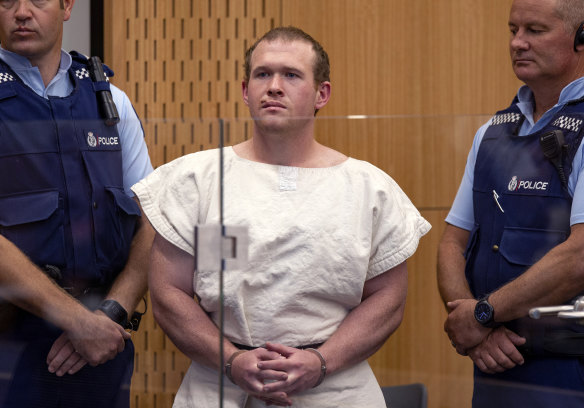
Tarrant's first court appearance, the day after the shootings at which he pleaded not guilty to murder.Credit: AP
Moving to New Zealand in August 2017, Tarrant rented a well-maintained wooden duplex in Dunedin, of the sort built as public housing in the lean years after World War II. With a single living level above a basement and a shared centre wall, the house is on a long street that runs from Otago Harbour’s pretty waterfront up a valley to the prosperous heights of Shiel Hill. The type of place that would attract students or those making do on a low income, it lies midway up the slope, on an unlovely stretch that one local observes lies in deep shade for most of Dunedin’s long winter.
His lease was to expire in March 2019 and he told his property manager – it’s not known exactly when – that he would not need to renew it.
Tarrant’s immediate neighbours say that he was so quiet, they didn’t hear a TV or music from his side of the wall. Another neighbour – the man confronted by police the day of the massacre – remembers a polite and unremarkable bloke who often came and went wearing trainers, jeans and a hoodie, carrying a gym bag. Tarrant had little furniture and kept the house neat and clean.
There is no evidence he had a job in Dunedin, nor that he had established any friendships. He joined Anytime Fitness and was known to grunt and sweat on the free weights just as he had in Grafton. The gym lies on a strip mall on a busy arterial road. Directly opposite is the An-Nur childcare centre with an English sign that reads in bright green and red lettering, Allah Bless Our Country, Land of Love and Compassion … All Kids Welcome.
A month after he signed his lease, Tarrant applied for a gun licence, and in October 2017 a police firearms vetting team visited his home to interview him and inspect its security. According to police, he provided the names of two New Zealand residents as references, though they have not been identified. They were also interviewed by police and met "the requirements of the process".
His licence was approved in November and between December and the following March, he bought four guns and ammunition from the New Zealand dealer Gun City. David Tipple, Gun City’s owner – a prominent and controversial gun lobbyist in New Zealand – says that as far as he can tell, he did not sell Tarrant the AR-15 military-style semi-automatic with which he killed most of his victims.
In Dunedin, Tarrant's mother 'thought he was in a bad place then, because he got the guns out of the car and showed them'.
Last Christmas, Tarrant’s mother Sharon and her partner Gerald made a trip to New Zealand, during which they visited Tarrant in Dunedin. His grandmother Marie Fitzgerald says the trip did not go well. "They thought he was in a bad place. He was not happy to see them, apparently," she tells Good Weekend. "It was interrupting with his way of life. He had settled down there and they thought everything was hunky-dory and, needless to say, he wasn’t very happy."
At some point during the visit, Tarrant shocked them by showing off his gun collection. "They just thought he was in a bad place then, because he got the guns out of the car and showed them that he had guns," she says. "If your son does things like that, you think, ‘My god’. He was never allowed to have guns as a little kid.
"He said he was in a rifle club or something; it wasn’t the best thing to be in, but he had to occupy his time somehow.
"They didn’t tell me for ages [upon their return] that he wasn’t in a good place. The place he had there was no place for visitors. Sharon wasn’t happy. She felt that he was in the wrong state of mind. They just went on with their holidays, came home and they said they’d had a lovely time and that was it. I don’t think Brenton and Gerald ever got on very well; you couldn’t replace Rodney."
There is no suggestion that Sharon Tarrant or Gerald Tory knew that Brenton was a danger to the public.
Apart from the gym, Tarrant’s only other well-known haunt was the Bruce Rifle Club’s shooting range, known as Narrowdale, about 40 minutes’ drive south of Dunedin. It is the oldest range in the country and one of the few that caters to long-range shooters using the sort of military-style rifles Tarrant used. Once open dairy country, the land on which it lies is now owned by a forestry company, and thickly wooded. The range has been closed since the massacre and any sign of it is hard to find without directions.

Signs to the shooting range used by the Bruce Rifle Club. Tarrant became a member of the club in 2017.Credit: Hamish McNeilly/Stuff
On a recent visit on a wet afternoon, mist clings to the treetops and there’s silence but for rainfall and bird song. A sign by its gate is all but obliterated by a shotgun blast. There’s a hut storing dusty targets and battered chairs; beyond it is the range itself, an open field climbing even higher up the hill ringed by fir trees and Australian blue gums that grow here as weeds. It’s hard to imagine a more beautiful place to practise a sport.
On November 17, 2017, the same month that Tarrant received his gun licence, Pete Breidahl attended a military-rifle shooting event at Narrowdale that left him shocked. Breidahl is a 40-year-old dual Australian and New Zealand national who now works as a horse-breaker; he once served as a machine gunner in the New Zealand Army. As a former member of its Combat Shooting Team, he was drawn to the Narrowdale event.
The meet attracted a larger crowd than normally attended the club’s fortnightly meets, and according to Breidahl, some of them were "not f---ing right". He says one group, dressed in camouflage, discussed Australia’s 1996 Port Arthur massacre at length, at which Martin Bryant killed 35 people and wounded 23, suggesting the shooting was too fast and too accurate, and that some sort of conspiracy must have taken place. Breidahl believes one of the men in that conversation may have been Tarrant. Though he became a member soon after, there is no confirmation that Tarrant attended the meeting.
A Facebook conversation Breidahl had on November 20 showed just how concerned he was. In it he told a friend that he’d been up all night thinking about an incident. "I had a guy telling me, fully believing what he was saying, that because we were letting refugees in that we will have the army deployed on the streets of Dunedin due to all the terror attacks," he wrote. He went on to describe what he considered dangerously lax range rules, shooters decked out in military gear and living out zombie-apocalypse fantasies, others fretting about government interference. It was, he said at one point, like an NRA meeting from 1980.
"There were some guys here with pretty strong feelings about guns, and one in particular really had me very worried. He was complaining about skateboarding kids at the uni, saying if they can carry their boards, he should be allowed to carry a gun," he wrote. "I was literally scared." A friend responded that he should go to the police in case there was another "Aramoana situation", referring to a spree killing of 13 people that took place not far from Dunedin in 1990, another massacre by an angry man with a military-style semi-automatic rifle.
Breidahl tells Good Weekend that some days after the shooting meet, he visited Dunedin’s central police station to voice his concerns. He says he was told police were aware of the club and that its members were just "silly old duffers". New Zealand Police says it has no record of this report. The day after Tarrant’s attack, Breidahl went public with a Facebook video post that went viral.
"What do you f---ing know?" he said. "It turns out that the guy who f---ing murdered everyone in Christchurch was a member of the Bruce Rifle Club … hand on my heart, I did everything I could, I warned the cops."
Club officials declined to speak with Good Weekend, though two days after the shooting, vice-president Scott Williams told Nine’s New Zealand website Stuff that his members were "shocked and stunned" and that the club would carry out a review of its culture. "We certainly don’t breed any mass killers," Williams said, adding that "I think we’re all pretty … saddened." He denied Breidahl’s claims.
Since he went public, Breidahl himself has been charged with a firearms offence, which he was contesting at the time of writing. One of his friends says he believes Breidahl has been targeted because he’s embarrassed the police by coming forward.
Breidahl has also shared with Good Weekend another Facebook message sent to him following Tarrant’s killing spree and his own subsequent angry video post. Its author claimed to be a member of the Bruce Rifle Club. "I totally agree with what you are saying," he wrote. "The last time I was down there the shooter [Tarrant] was there and displayed a horrible shooting style by shooting of [sic] multiple rounds at once and then changing magazines. This sent alarm bells off and I notified the club but nothing was done."
Settled in Dunedin with a gym membership, guns and a gun range, Tarrant turned to crafting his manifesto. Entitled The Great Replacement, the document was divided into four sections and dressed up portentously with verse. Dylan Thomas’s Do Not Go Gentle into That Good Night was reproduced at the start, and William Henley’s Invictus was tacked on towards the end.
Tarrant claimed that his first draft was 250 pages long, but that he deleted it and rewrote a shorter version of 74 pages. Littered through it was the language of 4chan and 8chan – gags and misdirection and laboured irony. At one point Tarrant dropped into a Q&A section a meme that has been traced back to 4chan in 2010 and was known as "Marine Copypasta", in which an online tough guy claimed to be a US Navy Seal. "I’ve been involved in numerous secret raids on Al-Qaeda, and I have over 300 confirmed kills," it read. "I am trained in gorilla [sic] warfare and I’m the top sniper in the entire US armed forces. You are nothing to me but just another target."
Elsewhere, Tarrant joked sarcastically that video games made him a violent racist. "Spyro the Dragon 3 taught me ethno-nationalism. Fortnite trained me to be a killer and to floss on the corpses of my enemies." Passages like this led some to describe Tarrant’s writing as rambling or incoherent. In fact, what was most disconcerting was its clarity. Stripped of the memes, chan gags and patchy grammar, it was a direct statement of mangled history, vile ideology and deadly intent. Online plagiarism software checks suggested that his writing was original.
The QAnon researcher Julian Feeld says he’s not aware of any other killer who had demonstrated such a fluency in chan and gamer language and a proficiency with military-style weapons.
The document was loaded with the themes of Identitarianism. Tarrant argued for what the movement refers to as "ethnopluralism", the notion of preserving individual ethnocultural regions. "To Turks," he wrote at one point, "You can live in peace in your own lands, and may no harm come to you. On the east side of the Bosphorus. But if you attempt to live in European lands, anywhere west of the Bosphorus, we will kill you and drive you roaches from our lands." (This attitude might explain his apparent joy at travelling in Pakistan.)
He wrote that he intended for his attack not only to serve as revenge for Christians killed by Muslims in centuries of warfare, and not only to cause terror among Muslim communities he considered to be living outside their "homelands", but to also sow division in the US between gun owners and anti-gun campaigners or, as he saw it, between right and left. This would, he argued, weaken the US ability to project power as it did in Kosovo, where "US/NATO forces fought beside Muslims and slaughtered Christian Europeans attempting to remove these Islamic occupiers from Europe". Crucially, he intended to inspire further atrocities and help foment broader conflict.
Tarrant wrote that he was not a neo-Nazi, arguing that Nazis no longer existed as a political force. Rather, he said he embraced the terms "fascist" and "ethno-nationalist". He cited the far-right Norwegian mass-murderer Anders Breivik as an inspiration and said he had received approval for his attack from a shadowy organisation called the "reborn Knights Templar" that Breivik claimed in his manifesto to have co-created. European police agencies believe this group is a fantasy.
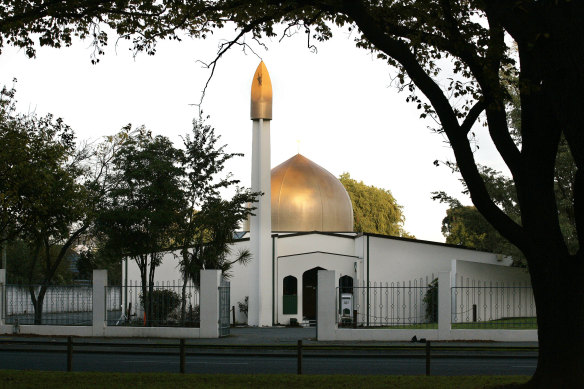
The Al Noor Mosque in Christchurch, where Tarrant's rampage began.Credit: AAP
On the morning of Friday, March 15, Tarrant left his home in Dunedin and drove alone to Christchurch, his car loaded with his guns and ammunition, his tactical gear and helmet, his camera and microphone rig. The drive north takes nearly five hours if you push through without a break, across what were the lands of the Ngai Tahu tribe before the arrival of the British. The single carriageway winds up the volcanic hills that ring Dunedin and meets the sea again on a plain so flat that the land itself seems to disappear into the Pacific, then twists through farmland marked by towering hedgerows.
In Christchurch, the community that Tarrant drove towards was preparing for its weekly congregational prayer. Friday prayers are not only the most sacred of the week, but a time to catch up with friends and family.
The community included Yama Nabi and his 71-year-old father Daoud, who had argued a few weeks earlier and not seen each other since. The falling-out was weighing on Yama’s mind, and Daoud had been missing Yama’s six-year-old daughter, Zahal. Yama decided to bring her with him to prayers so his father could spend time with them both, but he was running late. Daoud was well-known at the mosque. A leader in the Afghani community, he had a habit of greeting arriving Muslim refugees at the airport no matter where they’d come from.
Dr Muhammad Elayyan, the owner of the An-Nur childcare centre in Dunedin, was on time. The Elayyan family split their time between Dunedin and Christchurch and on that day, he arrived for prayers a few minutes before his son, Ata. Well-known about town, Ata had attended Christchurch Boys High and still coached its soccer team. A successful young executive, a former competitive computer gamer and a prominent app developer, married with a two-year-old daughter, he was the starting goalkeeper for the New Zealand Futsal Whites, the country’s national indoor-soccer team.
Daoud Nabi had a habit of greeting arriving Muslim refugees at the airport no matter where they’d come from.
At 1.34pm, as Tarrant drove through the leafy inner suburbs near the Al Noor mosque, he pulled over to flick on the camera on his helmet, and turn on his car stereo. He started streaming live on Facebook and posted to 8chan to direct an audience to it. "Well lads, it’s time to stop shitposting and time to make a real-life effort post," he wrote. "I will carry out and attack against the invaders, and will even live stream the attack via Facebook."
8chan viewers soon started expressing their joy that this was not some LARP (live-action role play), but genuine mass murder that they were being allowed to watch in real time. They shared screenshots of their favourite sections. "Best of luck Brenton Tarrant," wrote one. "Brenton Tarrant is a f---ing hero," posted another.
A racist ditty called Karadžic, Lead Your Serbs, a tribute to Milosevic henchman Radovan Karadzic’s ethnic cleansing of Bosnian Muslims and Croats, bled out of the Subaru’s stereo. Tarrant’s camera showed a pile of loaded magazines in his lap, three long-arms on the passenger seat and an assault rifle by his right leg. All the hardware was scrawled with the slogans and names of Tarrant’s Identitarian heroes.
"Remember lads, subscribe to PewDiePie," Tarrant said into his microphone, a reference to a popular Swedish YouTuber with a history of posting anti-Semitic imagery. It was one more ironic little wink to his chan audience before he started to kill.
Tarrant’s entry into the mosque was so fast and violent that Muhammad Elayyan was still on his knees at prayer when he was shot. One round went through his shoulder and another hit him in the side of his head. He survived, but learnt when he came out of surgery that his son Ata had not.
When Tarrant first arrived, Yama and Zahal were still parking. Daoud, the man who greeted refugees at the airport, was by the front door. Tarrant approached, clad in his body armour, strapped with his guns. Still Daoud offered the customary welcome.
"Hello, brother."■
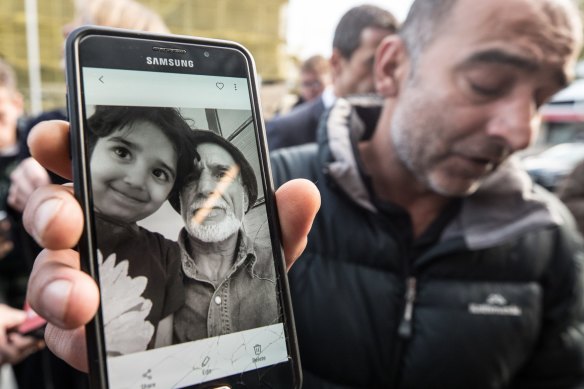
Yama Nabi holds a photo of his father, Haji Daoud, 71, who was killed in the Masjid Al Noor Mosque in Christchurch.Credit: Jason South
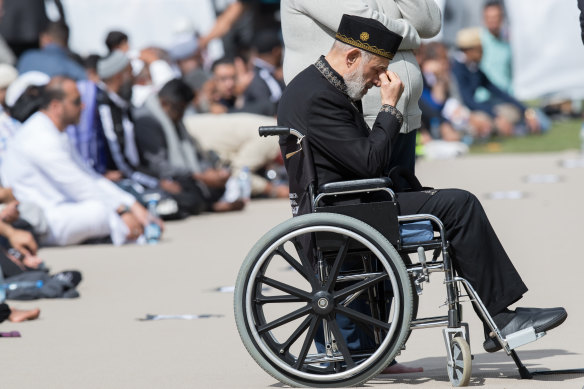
Dr Muhammad Elayyan, father of Ata Elayyan, who was killed at the Al Noor mosque, at a prayer service in Christchurch a week after the shooting.Credit: Jason South
Brenton Tarrant has been charged in New Zealand with 51 counts of murder, 40 of attempted murder and one of engaging in a terrorist act. In June, he pleaded not guilty to all charges. His trial is expected to begin in May next year.
To read more from Good Weekend magazine, visit our page at The Sydney Morning Herald, The Age and Brisbane Times.